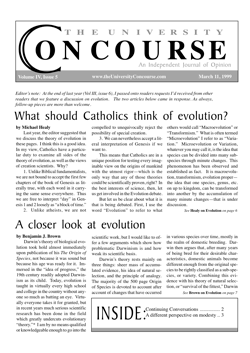A closer look at evolution
by Benjamin J. Brown
Darwin’s theory of biological evolution took hold almost immediately upon publication of his The Origin of Species, not because it was sound but because his age was ready for it. Immersed in the “idea of progress,” the 19th century readily adopted Darwinism as its child. Today, evolution is taught in virtually every high school and college in the country without anyone so much as batting an eye. Virtually everyone takes it for granted, but in recent years much serious scientific research has been done in the field which greatly undercuts evolutionary “theory.”1 I am by no means qualified or knowledgeable enough to go into the scientific work, but I would like to offer a few arguments which show how problematic Darwinism is and how weak its scientific basis.
Darwin’s theory rests mainly on three things: sheer mass of accumulated evidence, his idea of natural selection, and the principle of analogy. The majority of the 500 page Origin of Species is devoted to account after account of changes that have occurred in various species over time, mostly in the realm of domestic breeding. Darwin then argues that, after many years of being bred for their desirable characteristics, domestic animals become different enough from the original species to be rightly classified as a sub-species, or variety. Combining this evidence with his theory of natural selection, or “survival of the fittest,” Darwin has a strong case for the natural evolution of varieties within species, what is known as micro-evolution. By itself this is uncontroversial, supported by the evidence, and a significant contribution to natural science.
The problems enter when Darwin makes the leap to macro-evolution, or evolution of one species from another. This great shift from qualitative changes within species to macro-evolution is an unjustified conclusion, supported only by a common trick of logic (N.B., I’m not impugning Darwin’s motives here), namely, an abuse of analogy. Darwin “reasons” like this: if it’s the case that species evolve into varieties after a sufficiently long time, then, given enough time, species could very well have been varieties to begin with, which finally differentiated themselves enough to be a separate species, and genera could have previously been only species, etc.
The logical conclusion of this analogy is that there was some one original animal from which sprung all modern species. One might also suppose that in the distant future, we will have to invent other categories to contain what are currently species as they evolve further.
This hypothesis is quite plausible at first glance. It makes sense that this is the way things could have happened. However, it certainly does not deserve the name of theory, as that word is currently used by natural science. A hypothesis becomes a theory by being tested and verified by the objective evidence. And Darwin’s theory has by no means been so verified—either by Darwin or anyone else. There simply is no hard evidence for macro-evolution. The only thing supporting it is the abused principle of analogy, which has been twisted from an explanatory device into a method of proof.
The people of Darwin’s time accepted his theory despite the dearth of evidence, because it fit well with so many other popular ideas of the age (e.g., materialism and the idea of progress.) By now it has become a part of our intellectual culture which is just taken for granted. It is high time, however, that we give it a more critical analysis.
Upon examination of Darwinism, several flaws become apparent. The first is the fact that there is a difference in kind, not just degree, between micro and macro-evolution. It is an entirely different thing to say that fish developed lungs than to say that pigeons developed longer beaks. The second is a simple change in quality, while the first is a radical change in structure. No amount of breeding is going to yield a dog with a fifth leg, no matter how much time you allow. And there is no such thing as a gradually evolving fifth leg; what in the world would that look like anyway!? To say that certain parts evolved gradually is often even more absurd than to posit an instantaneous appearance of an organ; we have at least seen mutated animals that had an extra limb, but we’ve never, that I’ve ever heard of, seen something that might properly be called a gradually evolving leg.
At this point many people would object by pointing out things like flippers and wings which are commonly thought to be forerunners of arms. All this shows, though, is a further abuse of analogy. Just because there are structural similarities between two parts or organs does not mean that one developed from the other or that they both developed from a common ancestor. But this is precisely what evolution claims as true. Yet there is not one shred of evidence that any such thing actually happened. We’re only convinced because we can see certain structural similarities. And that is as far as evolutionists go; there is no real explanation of how such a process of development from flipper to arm might have taken place. As “evidence” for this theory, evolutionists point out a series of limbs (e.g. fish fin, shark fin, dolphin flipper, walrus ‘arm’, otter arm, etc.) that look like they could be intermediate stages, which is far from proving the point.
I personally can’t even imagine how a flipper might be made to change ever so slightly so as to gradually develop into an arm. I highly doubt that it’s even genetically possible, unless one posits genetic mutations, which brings another whole set of problems into the picture. In any case, there is no doubt that the explanation offered by Darwinism (i.e., natural selection) is insufficient. For example, I can see how a longer or stronger flipper might help a dolphin to survive better and pass on its genes to its offspring. But I cannot see how anything resembling a finger, or a little bump that might be the beginning of a finger, or a narrower flipper, or any number of other things that might be intermediate stages, is going to help a dolphin survive better and pass on these characteristics. Gradual qualitative improvements can help an animal survive better, but I cannot see how structural changes, when looked at on the gradual level, are going to offer an animal any better chances of survival.
Another point which I would like to address is that of intermediates. Evolution assumes a very, very gradual process (millions of years) of accumulated changes, which means that there have been many thousands of intermediate species between each modern species and its ancient predecessors. The problem is, where are their fossils? The geological record in no way gives evidence that millions of other species existed. Darwin addresses this problem, but quite unsuccessfully. He conceded that the geological record was imperfect, and dedicated the whole of chapter 10 to trying to resolve this problem. Ultimately, he is unable to solve the problem convincingly, and a century and a half later, after major developments in technical capabilities and massive amounts of geological research, we are little closer to verifying evolution. Rather than concluding that the geological record is imperfect, it seems more sensible to conclude that the “theory” of evolution is imperfect.
Lastly, I would like to address the issue of specialization. An obvious question should occur to anyone who gives evolution any serious thought: If a given attribute helps an animal survive better, then why wouldn’t several such attributes help even more? For example, if gills allow a fish to breathe under water, and mammals developed from fish, then why would mammals lose their gills? Certainly they would be better able to survive if they had both lungs and gills. Darwin’s answer is that no one doubts the value of the physiological division of labor. That is, each animal fills a particular niche, just as each person on an assembly line does one particular task. Darwin considers this to be the end of the matter, because he’s relying on the common notion of his time and ours that specialization is more efficient that generalization. He entirely misapplies the principle, though. Division of labor only works in the context of a group effort, when each person is doing his own part. With animals, however, it is individual survival that is important, so the more beneficial qualities one has the better. If evolution were a valid theory, it would seem that animals should be getting more generalized, not more specialized.
In conclusion, Darwinism reminds me of the movie Angels in the Outfield, throughout which is repeated the line “It could happen.” There is no direct evidence that evolution takes place, only a number of facts that seem to be explained by positing it. The problem is that more difficulties arise than are explained. A less all-encompassing, but more coherent and sound theory would be to posit independent creation along with a certain degree of micro-evolution.n
Ben Brown is a senior mathematics/computer science/theology major.
He is also president of the Franciscan University Student Forum, and a Contributing Editor of the Concourse.
- See such authors as Michael Johnson, Phillip Johnson, and Michael Behe. ↑


